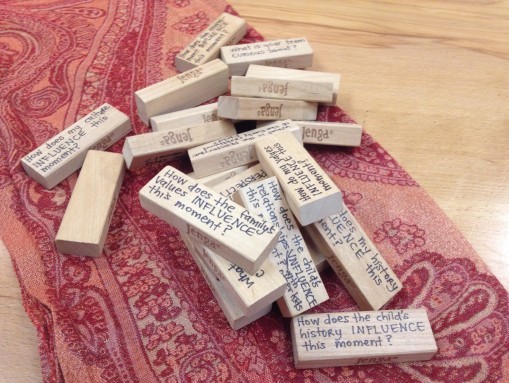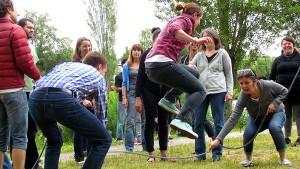
Reflective Planning for Professional Development
by Sandra Clark, Mentor Teacher and Professional Development Coordinator, Hilltop Children’s Center
As I began my role as a professional development coordinator this year, I was filled with many intimidating questions. How could my co-coordinator and I meet the needs of all the staff? How could we build upon our school’s history of professional development? How would this role interact with our existing role as mentor teachers?
Emily and I took some time for reflection and study – of feedback from staff, of our own experiences in the field, and of larger conversations happening in the field of education. That reflection and study, along with Peter DeWitt’s article, “Please No More Professional Development,” have been helpful in processing the past and formulating goals for future professional development.
As we continue to seek answers to our original questions – and learn more about professional development and our role as coordinators, we’ve developed some questions that we ask ourselves informally while planning each faculty meeting or in-service day. We used these questions when putting together the details for a recent in-service day about partnerships with families.

What is our goal for this professional development session?
We hoped teachers would come away with a new understanding of parent perspective, using it to increase partnership. It could be difficult, at times, for teachers to figure out how to best move forward when their own values about working with children didn’t align with a family’s.
How can we connect this PD with past PD and other goals?
As a center that values anti-bias education, we saw this work fitting into the second core goal of anti-bias education, helping staff “express comfort and joy with human diversity” as they increased their knowledge and understanding of families’ values and practices.
This also connected to our school’s goals to create a community culture that approaches differences with curiosity rather than judgment, and sees conflict as an opportunity for collaboration, both in our work with families and children, but also in our partnership with co-teachers and other staff.
How can we access and use the resources we already have available?
We hoped to bring out the knowledge, history, and skills present in our staff through small and large group discussions. Staff members shared both tricky conversations and situations that went well and reflected why difficult conversations and scenarios may not have gone as well. We ended up with a list of strategies and “sound bites” we learned from one another.
Emily and I also invited our executive director, Liddy, to share her expertise about Hilltop’s commitments to families and teachers. She offered reminders of expectations around professionalism and the school’s processes for addressing family complaints or issues.
How can we add new or different voices and information to our conversation?
In the past, our school has invited parents to share their perspectives in person or emotional intelligence coaches to offer their know-how. For this particular session, we sent a survey to families to help answer questions about their perspective like “What makes your family different than other families you know?” and “What would you like teachers to know about being a parent?” We studied the results of these questions together to gain a better understanding of our current families.
We also made space to read “We Have to Talk: A Step-by-step Checklist for Difficult Conversations” and answered the questions posed by Judy Ringer, helping us to reflect upon how we can thoughtfully prepare in advance for complicated conversations with families.
How can we make this PD relevant, applicable, and inspiring?
Staff spent time at the in-service discussing and roleplaying scenarios, both those that often come up and those that we were currently working through. We applied what we had learned that day as we brainstormed strategies for how to talk with a grandparent when their grandchild was injured, but no one saw how. We tried out actual phrases we might use if a parent started asking about the behavior of another child in the class.
We offered challenges and reflection to help staff shift their thinking. Together we compared our “image of the child” alongside our “image of the family.” How and why were they similar and different?
We made short-term and long-term commitments, asking staff “What are your hopes for in your partnerships with families?” and “What does this look like?”
Emily and I introduced tools that we have found useful in our mentoring including “circle of control,” which aids individuals in thinking about what they have control or influence over, and what they do not. We also shared Mary Beth O’Neill’s concept of backbone and heart, which encourages professionals to “clearly articulate where you stand” while “stay[ing] connected and tuned in” as you do so. We hoped these emotional intelligence tools would be something staff would apply the next day and/or a year from now.
How can we continue this learning beyond the in-service day?
In the following week we sent an email to staff with discussion notes, additional articles and resources, and a list of the commitments we had made.

In addition, we are in the process of creating a framework for having tricky conversations with families, using the strategies and “sound bites” collected during the session.
Emily and I have also used this shared experience as a reference point in our on-going work with individual teachers and teaching teams. As we mentor and work together with them, we can reference the thinking and tools from that day. We continue asking staff to consider “What do parents need to hear?” What else might be contributing to this?” and “What needs to happen to maintain partnership?” as they prepare for communication with families.
Emily and I certainly don’t have all the answers about professional development. These questions, though, help us to think more thoroughly and intentionally about what should be included in each faculty meeting or in-service day. What questions do you ask yourself when planning for faculty meetings or in-service days at your school? How and why are they similar to or different from the ones that my co-coordinator and I ask ourselves?
[author] [author_image timthumb=’on’]https://hilltopcc.com/wp-content/uploads/2016/05/Sandra-Clark.jpg[/author_image] [author_info]Sandra Clark is a Mentor Teacher and Professional Development Coordinator at Hilltop Children’s Center, where she has worked since 2010.[/author_info] [/author]
2 thoughts on “Reflective Planning for Professional Development”
Comments are closed.
So helpful and inspiring — in concrete and abstract ways. Thank you for being so open with us!
What a lovely example of reflective practices for those who design PD for staff. Appreciate seeing both the process you use and some specific examples. I can imagine this example being a study tool for PD planners across many roles.